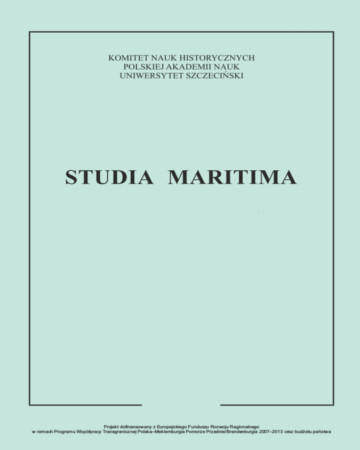






| Authors: |
Radosław
Gaziński
Instytut Historii i Stosunków Międzynarodowych, Uniwersytet Szczeciński |
| Keywords: | Pomeranian history Kołobrzeg harbour harbour administration |
| Data publikacji całości: | 2017 |
| Page range: | 17 (23-39) |
| 1. | Baasch, Ernst. Beiträge zur Geschichte des deutschen Seeschiffbaues und der Schiffbaupolitik. Hamburg: L. Grä fe & Sillem, 1899. |
| 2. | Benoit, Roloff. „Baugeschichte des Hafens Kolberg”. Zeitschrift für Bauwesen XLIX (1899): 4–6, 249–270. |
| 3. | Cramer, Hermann. Zur Geschichte der Saline zu Kolberg und ein Gutachten A von Humbolt gegen Ende des 18 Jahrhunderts. Halle, 1892. |
| 4. | Dzieje Kołobrzegu (X–XX wiek), red. Henryk Lesiński. Poznań: Wydawnictwo Poznańskie, 1965. |
| 5. | Ellmers, Detlev. Koge Kahn und Kunststoffboot. 10 000 Jahre Boote in Deutschland. Bremenhaven: Dt. Schittahrtsmuseum, 1976. |
| 6. | Ewe, Herbert. Schiffe aus Siegeln. Rostock: VEB Hinstorff Verlag, 1972. |
| 7. | Gasztołd, Tadeusz, Hieronim Kroczyński, Hieronim Rybicki. Kołobrzeg: zarys dziejów. Poznań: Wydawnictwo Poznańskie, 1979. |
| 8. | Gaziński, Radosław. „Szczecińska gospodarka morska na przełomie XVIII i XIX wieku– stagnacja czy rozwój?”. Przegląd Zachodniopomorski 3 (2005): 7–20. |
| 9. | Gaziński, Radosław. „Z dziejów portu darłowskiego w latach 1630–1668”. Materiały Zachodniopomorskie 41 (1995): 389–399. |
| 10. | Gaziński, Radosław. „Z dziejów prac pogłębiarskich na Zalewie Szczecińskim (XVIII w.)”. Przegląd Zachodniopomorski 34 (1990): 157–170. |
| 11. | Heinsius, Paul. Das Schiff der hansischen Frühzeit. Weimar: Böhlau, 1986. |
| 12. | Historia Pomorza, t. 2, do roku 1815, cz. 3, Pomorze Zachodnie w latach 1648–1815, red. Gerard Labuda. Poznań: Wydawnictwo Poznańskie, 2003. |
| 13. | Kausche, Dietrich. „Das Kolberger Saltz und sein Absatz im Mittelalter als Forschungsproblem”. Baltische Studien 64 (1978): 7–20. |
| 14. | Kołobrzeg i okolice poprzez wieku. Studia i szkice, red. Radosław Ptaszyński. Szczecin: Kadruk, 2010. |
| 15. | Kroczyński, Hieronim. Dzieje Kołobrzegu. Kołobrzeg: Kołobrzeskie Towarzystwo Społeczno-Kulturalne, 2000. |
| 16. | Lesiński, Henryk. „Główne linie rozwoju społeczno-gospodarczego w XIII–XVIII wieku”. Szczecin 1–2 (1960). |
| 17. | Lesiński, Henryk. Handel morski Kołobrzegu w XVII i XVIII wieku. Szczecin: Wydawnictwa Nauk. Wyższej Szkoły Pedagogicznej w Szczecinie, 1982. |
| 18. | Lesiński, Henryk. „Rozwój handlu morskiego Kołobrzegu z krajami Skandynawii w XVII–XVIII wieku”. W: Ars Historica. Prace z dziejów powszechnych i Polski. Prace dedykowane prof. Gerardowi Labudzie w 60. rocznicę urodzin. Poznań: Uniwersytet Adama Mickiewicza w Poznaniu, 1976. |
| 19. | Lesiński, Henryk. „Sól kołobrzeska w XVII i XVIII wieku”. Zapiski Historyczne 44 (1979): 5–23. |
| 20. | Majewski, Aleksander, Zbigniew Dziadziuszko, Alicja Wiśniewska. Morfologia powodzi sztormowych 1951–1973. Warszawa: Wydawnictwa Komunikacji i Łączności, 1975. |
| 21. | Matysik, Stanisław. Prawo morskie Gdańska: studium historycznoprawne. Warszawa: Wydawnictwo Prawnicze, 1958. |
| 22. | Mews, Eberhard. „Kolberger Seestreitkeiten mit Köslin”. Heimatkalender des Kreises Kolberg (1925). |
| 23. | Poppe, Karl. „Das Kolberger Seglerhaus”. Kolberger-Körliner Heimat – Kalender für das Jahr (1927). |
| 24. | Riemann, Hermann. Geschichte der Stadt Kolberg. Kolberg: Carl Jande Verlag, 1924. |
| 25. | Stoewer, Rudolf. Geschichte der Stadt Kolberg. Kolberg: C.F. Post’sche Buchdruckerei und Verlag, 1927. |
| 26. | Szopowski, Zbigniew. Małe porty Pomorza Zachodniego w okresie do drugiej wojny światowej. Warszawa–Poznań: Państwowe Wydawnictwo Naukowe, 1962. |
| 27. | Wachsen, Johann Frierdrich. Historisch-diplomatische Geschichte der Altstadt Colberg darin die Nachrichten von Burg von Hochwürdigen Dom – Capitel und Koniglichen Jungfrauen – Closter ertheilt und durch viele eingestreuete Oryginal – Urkunden in ein Licht gesetzet warden. Halle: Johann Justinus Gebauer, 1767. |